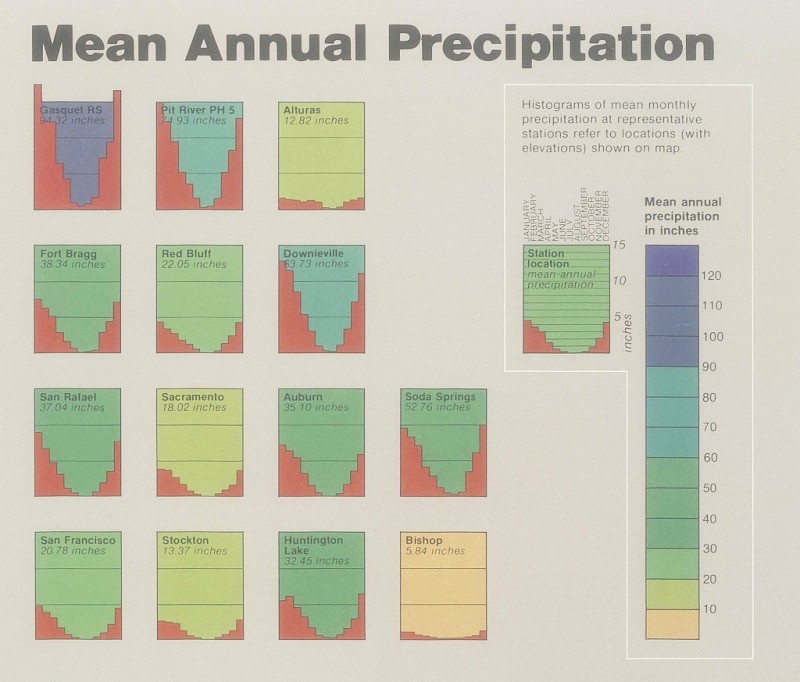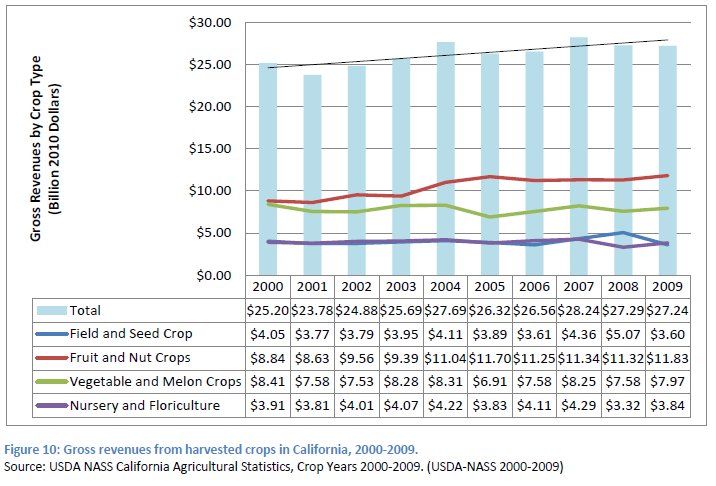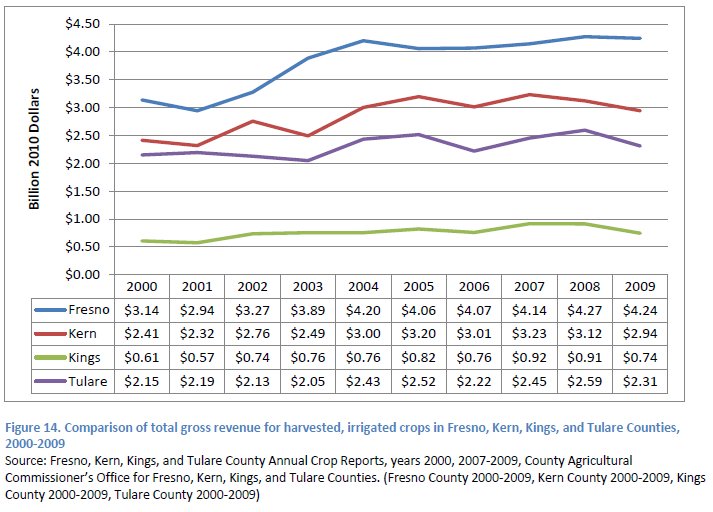 Figure 1: Monthly average precipitation showing the seasonality of precipitation in different parts of California, from the iconic California Water Atlas.
Figure 1: Monthly average precipitation showing the seasonality of precipitation in different parts of California, from the iconic California Water Atlas.
California has a “Mediterranean” climate, which means that each year it has a concentrated rainy season, followed by a long temperate and dry period. California’s rainy season typically runs from early October to late March, with very little precipitation outside of these months. (Figure 1 shows the average monthly rainfall for California.) It is now early 2014 and the rains have not come, for the third year in a row. While the definition of “drought” varies from place to place, it is safe to say that California is currently suffering from a severe – and by some measures, unprecedented -- drought.
It is not too late for some big storms off the Pacific Ocean to bring relief. But the odds are against it and current meteorological conditions are not encouraging. If the rest of the winter months are dry, or even of average wetness, the state will have much less water than normal, and much less than water users want – from cities to farms to our natural ecosystems.
We've had dry periods before – they are a recurring feature of our variable climate. The difficulty, expense, and pain of droughts, however, depend on two things: how severe they are and how we react. The Pacific Institute has spent many years studying the effects of droughts in California and has published several analyses of past impacts and responses (here and here).
Based on past experience, here is (part of) what Californians can expect this year if it remains as dry as it is now.
1. Urban water agencies will (and are beginning to) roll out a wide range of voluntary and mandatory water “conservation” programs. These typically ask customers to limit discretionary water uses such as watering gardens and washing cars and sidewalks. As droughts worsen, agencies expand these programs to offer incentives for both structural and behavioral changes: purchase more water-efficient appliances, remove grass and plant water-efficient gardens, cut shower times, and more. In the past, these kinds of programs and educational efforts have temporarily cut urban water use by between 10 and 25% depending on the programs and level of effort.
2. Some farmers and water districts with “junior” water rights will see water allocations from state and federal irrigation projects severely cut; some growers with “senior” water rights will see modest or even no shortages at all. Farmers with water shortages have some options: seek temporary water transfers from other users, increase pumping of local groundwater, change the kinds of crops they grow, or leave some lands fallow. These actions can impose local economic hardships, especially for low-income communities in affected regions. (Interestingly, however, recent severe drought from 2007-2009 did not lead to a significant drop in total statewide agricultural revenue or production. Figures 2 and 3 show total California agricultural revenue and revenue for the four major Central Valley counties for the period 2000 to 2009, showing the economic resilience of the sector during the 2007-2009 drought because of the buffering effect of some high crop prices, temporary use of expanded groundwater pumping, water transfers, and other factors.)
 Figure 2: Agriculture revenue by crop type in California, 2000-2009, including during the 2007-2009 drought (billion 2010 dollars). (From Fig.10 in Pacific Institute study.)
Figure 2: Agriculture revenue by crop type in California, 2000-2009, including during the 2007-2009 drought (billion 2010 dollars). (From Fig.10 in Pacific Institute study.)
 Figure 3: Agriculture revenue in four major agricultural counties in California, 2000-2009, including during the 2007-2009 drought (billion 2010 dollars). (From Figure 14 in Pacific Institute study.)
Figure 3: Agriculture revenue in four major agricultural counties in California, 2000-2009, including during the 2007-2009 drought (billion 2010 dollars). (From Figure 14 in Pacific Institute study.)
3. The generation of hydroelectricity at California dams will drop dramatically from average levels because it varies directly with streamflow. Because renewable hydropower is among the cheapest and most versatile of electricity sources, California ratepayers will have to pay for more costly fossil fuels to make up for the difference. In the past, the drop in hydropower has been largely made up by burning more natural gas, costing Californians billions of dollars in added energy costs and generating more greenhouse gases to the atmosphere. The same is likely to happen this year.
4. Natural ecosystems are likely to suffer severely, especially fisheries in the Sacramento-San Joaquin river delta (the “Delta”). These ecosystems are already under severe pressures due to water diversions and other stresses. The California Department of Water Resources described some of these past drought impacts here (pdf).
5. During past droughts, political pressures have been applied to increase diversions of water away from ecosystems. Some groups and politicians have pointed to legal decisions restoring some minimum flows to ecosystems as the cause of hardship to some California agricultural interests and used droughts to push for exemptions from these decisions, increasing ever-present tensions among different California water interests. This is also likely to reoccur this year.
6. Wildfires could be more frequent or severe, and the wildfire season may expand into normally wet months. Soil moisture is already extremely low; vegetation is likely to die in the foothills, coastal ranges, and Sierra; and these factors can increase fire danger.
7. Prices of water are likely to rise, in part because of the real cost of water scarcity, and in part because our water rate designs still too often penalize efforts to conserve water, leading to higher rates during droughts even when water use goes down. The Pacific Institute has described water rate strategies to address this problem, but more could be done to improve rate designs.
Droughts are a natural part of our climate, even without the complication of climate change, which has the potential to significantly alter the patterns of both water availability and demand in the coming years. In part, our massive water infrastructure (dams, reservoirs, aqueducts, and management institutions) has been built to help us manage this natural variability. But we could all be doing much more to reduce our vulnerability to extreme events.
In the short term, water agencies, managers, and users will look to the temporary fixes mentioned above, including behavioral changes, to help cut demand for water to a level that more closely matches reduced supply – and we should not sacrifice our natural ecosystems for short-term water needs.
In the long term, we need to make permanent fixes (and prepare for climatic changes). Despite our efforts in recent decades, California water use still remains unnecessarily profligate and inefficient. Many of us still have old toilets, showerheads, washing machines, and other appliances and we must replace them. We still grow water-hungry field crops and even some fruits, nuts, and vegetables with flood irrigation and we must further improve irrigation efficiency. Some homeowners still insist on having lawns that mimic those in the humid East (or more accurately in far wetter England), and in our current climate we should instead plant native vegetation that uses less water. Most of us still pay too little for our water. Higher prices would more properly reflect the true cost of getting, treating, and using water in California, though we must also protect economically disadvantaged communities. And we must seek out and explore new, renewable sources of water, including especially water treatment and reuse, rainwater harvesting, and brackish water desalination. The reuse of water – already underway in some places around the world, including some efforts in California – is one of the most promising ways of expanding the apparent supply of water for many non-potable, and even potable, uses.
California is a spectacular home, and we choose to live in its dry and variable climate. Our water behaviors should match and respect this environment, even during normal times, but especially, and critically, during drought times.

I've been meaning to get rid of the grass in my little yard anyway. It requires a ridiculous amount of water.
And/or you can do this:
1) Keep a 5-gallon pail in the shower. When you turn on the shower, the aim it into the pail until the water warms up. Use that water for:
a) Toilet flushes. It takes about 1/2 gallon to flush #1, about 1.5 gallons to flush #2. It's easier if you keep a separate bucket for this purpose: pour enough the water from your shower water pail into that bucket, to enable flushing by quickly pouring the water from this second pail into the toilet.
b) Laundry. If you have a top-loading washer, take each day's worth of cold shower water and add it to the washer: after a few days, you have enough water in the washer to do your wash cycle.
c) Other misc tasks such as yard watering or vehicle washing.
2) If your laundry room has a "laundry sink" for catching the output from the washer: get a stopper on a chain or string. Watch your washer for one complete cycle (wash, rinse) to observe how much water goes into that sink. Put in the stopper at the last rinse cycle. If it appears that it's going to overflow, push the STOP button on the washer, pull the stopper, and let enough water drain out that you can finish the cycle and accumulate whatever water you can. The goal here is to be able to catch an entire laundry sink full of water, about 15 gallons, from the final rinse cycle. Then use a small bucket or suchlike to scoop that water into another bucket you can use for toilet flushes.
3) All of the above can be automated; I've designed a system for this (Peter, if you want my email address it's on this posting, or ask), but I'm not going to use this forum for advertising. Suffice to say, anyone with minor mechanical aptitude can do likewise. When everything is set up correctly, the cold water from your shower does all of your laundry, and the graywater from your laundry provides most of your toilet flushes. Frankly this should be in the building code, because it's far more acceptable to flush the toilet with used laundry water, than it is to "recycle" sewage into drinking water.
4) Replacing the lawn with climate-appropriate landscaping is the biggest thing any homeowner can do. If your HOA requires a lawn, raise a lawsuit. We need a state law that bars HOAs from requiring lawns or other inappropriate landscaping.
For over 40 years, the drinking water for the city of Windhoek (Namibia) has included recycled sewage, usually around 8% of the supply but it can go up to 24%. Water engineers who have seen the process told me they would be happy to drink water straight out of the plant but in fact it goes in to a reservoir where natural processes can do further cleansing. A by-product is water high in organic matter and minerals. This is used to irrigate public parks, a garden centre, boulevard trees and the university grounds.
I have been to Windhoek, been to their recycled water plant, and drunk the water directly. It is perfectly fine. Singapore does this too, even more successfully, and southern California has some new high-quality recycled water plants, though we do not use them for potable water reuse. Yet. Long past time we did, however, and that time is coming.
I would submit that it's more affordable, more energy-efficient, and more acceptable to the public, to change the building code to require household laundry-to-toilet graywater recycling, rather than to recycle sewage into drinking water. I've designed, tested, and used the complete automatic graywater system, and it works. Yo Peter, I'm almost at the point of deciding to open-source the whole thing, so if you're interested, pull my email address and write, or let me know where to reach you.
A couple more household tips:
One: how to flush less without raising a stink:
The obnoxious thing about "pee twice, flush once" is the smell. Here's how to put a stop to it in two easy steps:
Guys, sit down to pee. You won't magically turn into a gal by doing it; in fact, observant Muslim men are known to do it when wearing religious garb. The benefit is the same as when you pour yourself a beverage directly from the bottle into the glass, rather than holding the bottle a couple of feet above the glass: no splatter of little droplets all over the place.
Then, keep an extra water glass next to the bathroom sink. Put it under the faucet while washing your hands. It'll capture a half to a full glass of water that otherwise would have gone down the drain. Lastly, pour that half cup of water into the toilet at the front of the bowl. This will wash down the invisible but not un-smellable small film of pee that would otherwise remain on the ceramic and evaporate into the air. Thus the ceramic surface stays clean, the pee is all in the water in the bowl, and there's no smell in the room.
Two: save 1/3 of your laundry water painlessly:
Use 1/2 the normal amount of laundry detergent and skip the second rinse cycle. Detergent makers encourage using more detergent than necessary because it's more certain to get your clothes sparkling clean that way. But it also means two rinse cycles to get all the detergent out of the clothes. if you work indoors, your clothes don't get that dirty, and half (or less than half) the normal amount of detergent will suffice. Since there's less detergent in the clothes, it takes less water to rinse it out.
I am in complete agreement with Peter's article. The next 20-30 years will be a lot different than the last 20-30 years. Variability in changes that we are experiencing in our climate now in combination with a continued population increases will challenge our capacity to adjust in communities, especially at the individual level.
Enhancing individual adaptive capacity, being more collaborative, increasing our resourcefulness in finding solutions to daily issues and knowing the facts about our water supply and surrounding conditions will provide a means to easily cope with these circumstances.
We can do this by working together.